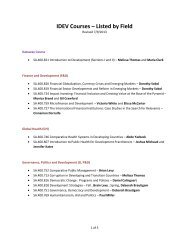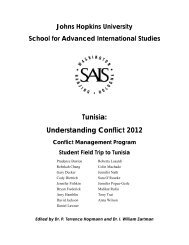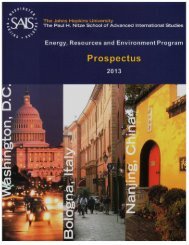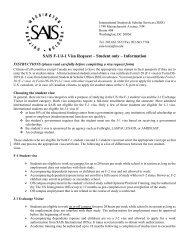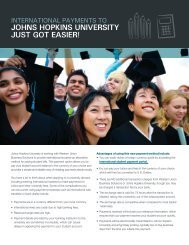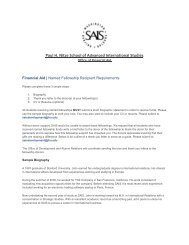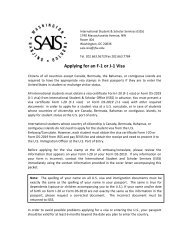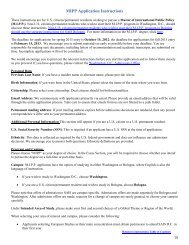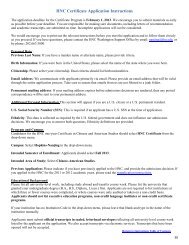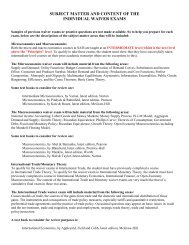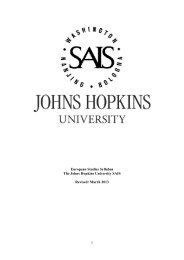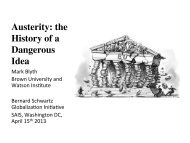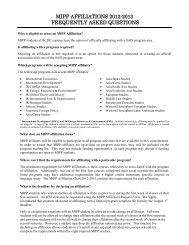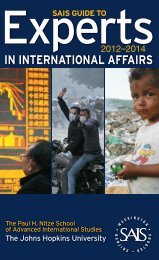energy, resources and environment program - Johns Hopkins ...
energy, resources and environment program - Johns Hopkins ...
energy, resources and environment program - Johns Hopkins ...
Create successful ePaper yourself
Turn your PDF publications into a flip-book with our unique Google optimized e-Paper software.
The Paul H. Nitze School of Advanced International Studies<br />
Energy, Resources <strong>and</strong> Environment Program<br />
Frontiers in Energy, Science <strong>and</strong> Technology Field Visits<br />
Frontiers in Energy, Science <strong>and</strong> Technology (FEST)<br />
To supplement its rigorous academic curriculum, the <strong>Johns</strong> <strong>Hopkins</strong> University School of Advanced<br />
International Studies - Energy, Resources <strong>and</strong> Environment Program, also developed the Frontiers in<br />
Energy, Science <strong>and</strong> Technology (FEST) Field Visits initiative to provide its students with first-h<strong>and</strong><br />
experience visiting a utilities, nuclear power <strong>and</strong> LNG plants, hydraulic fracturing <strong>and</strong> off-shore oil<br />
facilities, sewage treatment plants, <strong>and</strong> solar panel manufacturing facilities, among others. FEST offers<br />
student enrichment activities designed to provide first-h<strong>and</strong> exposure to innovations in the <strong>energy</strong> <strong>and</strong><br />
<strong>environment</strong> sectors.<br />
2011-2012 Program Activities<br />
Federal Energy Regulatory Commission (FERC) – November 18, 2011; November 9, 2012<br />
• 15 students<br />
• Visited FERC headquarters in downtown Washington, DC<br />
• Met with the Director of Public Affairs <strong>and</strong> technical support staff<br />
• Students gained a better underst<strong>and</strong>ing of US <strong>energy</strong> regulation, complexities of federal <strong>energy</strong><br />
laws <strong>and</strong> how FERC helps to coordinate <strong>energy</strong> distribution between states, given different state<br />
laws <strong>and</strong> different state interests (e.g., if a state in the south wants to obtain gas/oil from<br />
somewhere in the north, the states in between have to give their approval for pipeline<br />
construction, <strong>and</strong> this could cause conflicts <strong>and</strong> delays)<br />
Morgantown Generating Station – February 24, 2012<br />
• 21 students<br />
• Visited a coal-powered electrical plant in Charles County, MD with a 1467 megawatt capacity<br />
• Met with a team of engineers <strong>and</strong> senior plant operators<br />
• Heard a presentation about inputs for coal-powered electricity, costs of building <strong>and</strong><br />
maintaining a power plant (very high, can only build a plant if there is a near-guarantee that<br />
<strong>energy</strong> dem<strong>and</strong> will be high enough for the investors to recoup construction costs over time);<br />
learned about electricity production <strong>and</strong> pricing, EPA regulations <strong>and</strong> compliance<br />
• Observed heavy machinery, control room, furnace, scrubbers that remove <strong>environment</strong>al<br />
contaminants<br />
• Learned about the coordination process between an external <strong>energy</strong> production regulator <strong>and</strong><br />
the power plants that actually complete the <strong>energy</strong> production process<br />
US Green Building Council – March 2, 2012; October 26, 2012<br />
• 5-7 students<br />
• Tour of USGBC Platinum Headquarters in downtown Washington, DC (USGBC developed the<br />
LEED building certification system)<br />
• Met with researchers<br />
w w w . s a i s - j h u . e d u Page 41



